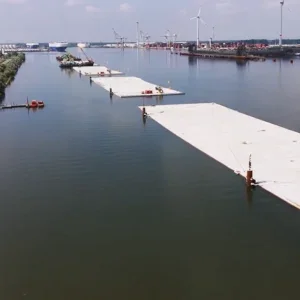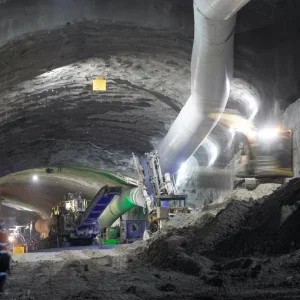The geotechnical behavior of volcanosedimentary rock materials during underground construction depends largely on the weathering level, and the speed at which weathering occurs.
The rocks under study correspond to a volcanoclastic sequence composed by planar strata with thicknesses that can go from centimetres to metres, these are alternate basalts, sandstones, tuffs, agglomerates, pyroclastic flows and lahars with variations in the grain size and composition.
The tectonic activity has affected some of these rocks a great number of times, but this was especially intense during the last Tertiary period.
Characterization of rock materials
At a shallow depth the amount of fractures in the rock is low, with RQD ranging between 80 per cent and 100 per cent, depending mainly on the kind of rock and the thickness of the stratum. In the case of metric strata of agglomerate the level of fracturing is low, while in thin layers of fine tuff the fracturing is quite blocky. Generally, the persistence of secondary joints is low, except for some irregular fractures filled with quartz and locally sulfides, with weak walls probably as the result of metamorphism due to the circulation of hydrothermal waters.
In general, the ranges of some parameters of these rocks are the followings. It is important to clarify that these numbers are not representative of failure or sheared zones:
- Density (kN/m3): 24- 26
- Geological strength index GSI: 50-60
- Uniaxial comprssive strength sci (MPa):
70-130 (basalt),
20-35 (siltstone – conglomerate)
30-60 (sandstone) - Parameter mi: 4 (clay stone), 15 (sand stone)
- Deformation modulus Ei (GPa): 4 – 35 (since limolita – conglomerate to sandstone)
In general, these types of rock have low density, high porosity and moderate to high elasticity module. Besides, it should be taken into account that in the Hock and Brown failure criterion, the strength values of the basalts with olivine (olivine toleiite) and the hyolite (rhyolite) were not used. The rock mass quality is very good generally except where there are faults.
Weathering in the tropics
The weathering process is a physical, chemical and biological phenomenon induced by the flow of oxygen and water. This phenomenon is also controlled by the type of minerals and the process of formation of the rock, among others.
To produce the chemical weathering the water is necessary and if it is at high temperature, the reaction speed will increase.
Chemical weathering is very intense in equatorial and tropical zones, mild in warm humid climate zones and low in extreme cold or extreme heat and low precipitation where the weathering is dominated by mechanical alteration.
Weathering processes of volcano sedimentary rocks at the tropics are accelerated by the tropical – humid climate and the basic mineralogical composition (high olivine basalts), calcium content, high porosity (of the sandstones) and low levels of formation (level four in Goldich, 1938 and Bowen scale) also contributes to the process.
It is very common to find that after few days the surface of a cut in rock would get soft.
In the case of tunnels, the change of consistency does not occur in days but slower, although it must be taken into account for long term designs and especially when these are going to be exposed to water flow with dissolved oxygen.
Deep water has no dissolved oxygen so therefore even though there would be saturated rocks, there is neither waterflow nor oxygen, thus the process is very slow (Fletcher 2006). Therefore if the tunnel walls are kept covered, so that there is no water flow and oxygen, accelerated weathering processes can be controlled.
Although different authors report weathering speeds in metres per millions of years, it should be clear that these refer to the deepening of the weathering profile which is given in millions of years, but in this case we are referring to the surface.
In the event that the material that softens is removed and once again fresh rock is exposed, the deepening will be much higher than that reported by different authors (Dosetto et al 2011) (Riebe et al 2003, 2004).
The factors that affect the weathering of volcano-sedimentary rocks are the mineralogical composition, the climate and the water flow.
According to the chemical composition and the aggregates formed, weathering for these rocks are:
- The basalt rich in olivine is very sensitive to hydrothermal weathering and to the effects of weathering.
- Detritic sedimentary rocks with feldspar which has high durability but is unstable in extremely hot and humid conditions due to the hydrolysis or cleavage of a molecule in the presence of water. As a result there is loss of minerals in the rock. Hydrolysis is the destruction of the original crystalline structure leading to the progressive separation of silica from other the elements, to the new formation of clay minerals and the deliverance of the metallic elements in the form of hydroxides.
- The shales with high silica content undergoes through a process of hydrolysis, that is, when is hydrated with water it becomes clay. Therefore its resistance decreases significantly. Sometimes when is slightly consolidated they are completely or partially undone with water.
Climate
According to the relationship climate – weathering proposed by Strachov (1967), the region in study corresponds to a moderate to very high decomposition zone, because the quantitative precipitation forecast (QPF) varies between 400 and 2000mm and the average annual temperature is between 5°C and 30°C.
Water flow
The factors that influence the ground water flow are the porosity and permeability. Therefore rocks that facilitate the flow of water are sandstones and limestones, as well as fractured zones. Sandstones have a porosity which can be between 12 per cent and 30 per cent, depending on the presence of fines and the grain size. The limestone has porosities between two per cent and 16 per cent. Therefore it can be slightly porous, or highly porous depending on the clay content.
Variation in resistance
The shear strength of the rock varies when the test is performed with natural moisture and a saturated sample. This range of variation is different for sedimentary rocks and volcanic rocks.
So when a tunnel is excavated and the hydraulic gradient is changed the flow of water is enhanced. Now the weathering process is accelerated and there is contribution to the saturation of the rock mass. Moreover, when the tunnels are for conducting water this saturation can be facilitated from inside to outside.
Conclusion
In volcano-sedimentary rocks localised in the tropics the weathering process is accelerated in presence of water and oxygen flow, given specific characteristics of climate, chemical composition and porosity of the rock.
So when a tunnel is excavated the flow of water and oxygen is increased and therefore weathering and degradation processes are activated. Additional investigations and controls are required in addition to those normally carried out in the design of a tunnel.
These must consider the mineralogical composition, mechanical and chemical variation with the flow of water and oxygen, and the strength mechanic of the rock in humid and saturated conditions.
This paper is intended to impress the importance of further studies, in addition to those customarily undertaken (shear strength tests, characterisation of mass rock and stress-strain analysis, because with standard tests is not possible to anticipate change and potential problems that can appear in a tunnel in Central America, or the tropics in volcano-sedimentary rock.







